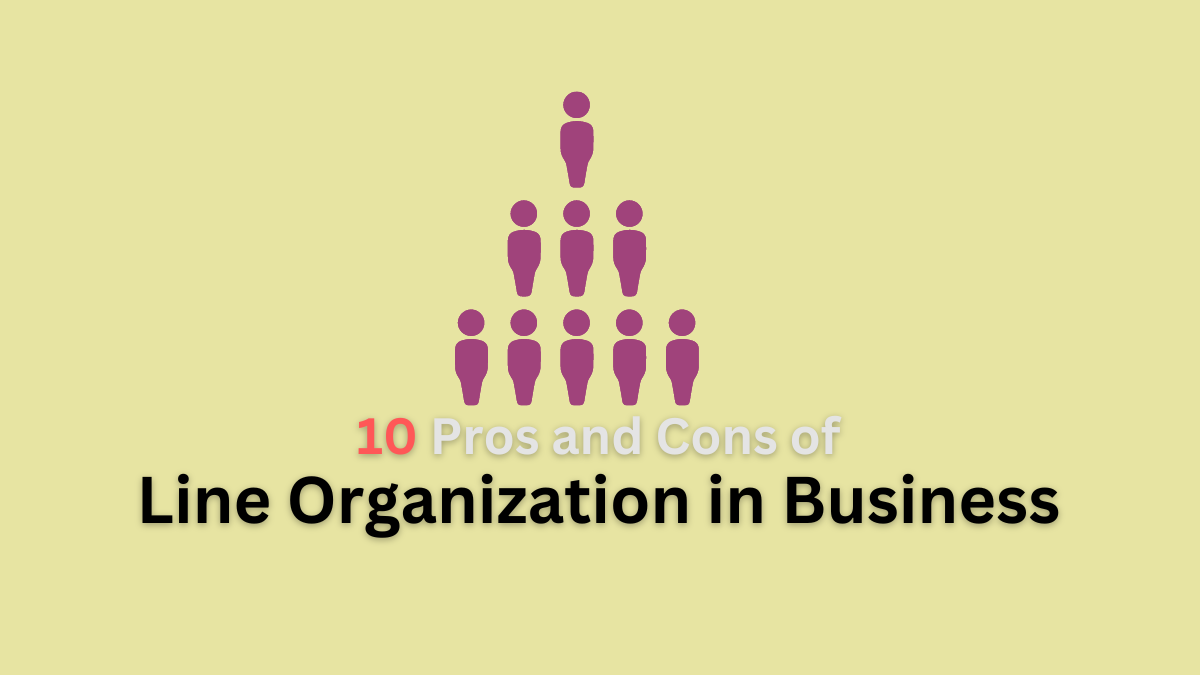Pros and Cons of Line Organization
Line organizational structure, also known as scalar, military, or hierarchical structure, is a framework where authority flows from the top to the bottom, and responsibility moves upward. This structure is characterized by direct vertical relationships connecting tasks and positions at each level with those above and below.
Here we will discuss 10 major pros and cons of line organization in business, so let’s get started:
Pros of Line Organization
Below are the five main pros of line organization structure in business:
Simplicity and Clarity
The line organizational structure is straightforward to understand. Each employee knows their specific role and the hierarchy of authority, which simplifies the communication and operational processes.
This clear delineation of responsibilities and authority helps in reducing confusion and ensures that everyone understands their duties and who they report to.
Quick Decision-Making
In a line organizational structure, decision-making authority is centralized at the top. This concentration of power allows top managers to make decisions swiftly without needing to consult with multiple parties.
This is particularly advantageous in situations requiring prompt actions and decisions, such as crisis management or rapid business changes, enhancing the organization’s responsiveness and agility.
Unified Control
Unified control is achieved through a clear hierarchy and direct lines of authority in a line organizational structure. Each manager has a well-defined span of control and is responsible for the performance of their subordinates.
This leads to better supervision, streamlined operations, and effective implementation of policies and procedures, promoting organizational discipline and consistency.
Fixed Responsibility
The line organizational structure ensures that responsibilities are clearly defined and fixed. Each position has specific duties, and employees are accountable to their immediate supervisors.
This fixed responsibility prevents the shifting of blame and fosters a sense of accountability, as employees know precisely what is expected of them and whom to report to.
Read More: 10 Major Pros and Cons of Group Decision Making in Business
Flexibility in Small Organizations
Although the line organizational structure is often criticized for its rigidity, it can be quite flexible in small organizations.
The clear chain of command and defined roles allow small businesses to adapt quickly to changes in the market or operational environment. Managers in smaller setups can make quick adjustments and decisions, thereby enhancing the organization’s ability to respond to external changes effectively.
Cons of Line Organization
Below are the five main drawbacks of line organization structure in business.
One-Way Communication
In a line organizational structure, communication primarily flows from the top down. This can result in a lack of feedback from lower levels, as employees might feel that their opinions and concerns are not valued or considered.
This one-way communication can hinder the flow of innovative ideas and improvements that often come from frontline employees, limiting the organization’s potential for growth and innovation.
Read More: 10 Major Pros and Cons of Job Enrichment
Overload on Top Officials
Centralized decision-making places a heavy burden on top managers, who are responsible for making decisions on a wide range of issues.
This can lead to managerial overload, where top officials are overwhelmed with tasks, reducing their efficiency and ability to focus on strategic planning. This can also lead to burnout and decreased job satisfaction among top managers.
Lack of Specialization
In a line organizational structure, managers and employees often handle multiple tasks and responsibilities. This lack of specialization can be a disadvantage, as it prevents individuals from developing expertise in specific areas.
The absence of specialized roles can lead to inefficiencies and suboptimal performance, as employees may not possess the necessary skills or knowledge to handle all aspects of their duties effectively.
Read More: 10 Major Pros and Cons of Job Enlargement
Potential for Autocracy
The concentration of decision-making power at the top can lead to autocratic leadership styles, where top managers make unilateral decisions without consulting subordinates.
This can create a work environment where employees feel disempowered and undervalued, leading to low morale and reduced job satisfaction. An autocratic approach can also stifle creativity and innovation, as employees may be less likely to suggest new ideas or improvements.
Rigidity and Inflexibility
While the line organizational structure can be flexible in small organizations, it tends to be rigid and inflexible in larger, more complex organizations. The strict hierarchy and fixed roles can make it difficult to adapt to changes in the external environment or to implement new strategies quickly.
This rigidity can hinder the organization’s ability to respond to market dynamics, technological advancements, and other external factors, limiting its long-term growth and competitiveness.
Hence, the above listed are the 10 main pros and cons of line organization structure in the workplace.
Read Next: 10 Major Pros and Cons of Job Rotation
